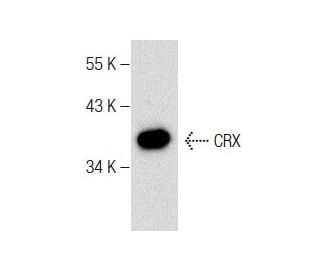


CRX Antibody (B-11): sc-377207
- CRX Antibody (B-11) is a mouse monoclonal IgG1 κ, cited in 1 publications, provided at 200 µg/ml
- raised against amino acids 166-285 mapping near the C-terminus of CRX of human origin
- recommended for detection of CRX of mouse, rat and human origin by WB, IP, IF and ELISA
- TransCruz reagent for ChIP application (sc-377207 X, 200 µg/0.1 ml)
- m-IgG Fc BP-HRP, m-IgG1 BP-HRP and m-IgGκ BP-HRP are the preferred secondary detection reagents for CRX Antibody (B-11) for WB applications. These reagents are now offered in bundles with CRX Antibody (B-11) (see ordering information below).
QUICK LINKS
SEE ALSO...
CRX Antibody (B-11) is a mouse monoclonal IgG1 antibody that detects CRX in mouse, rat, and human samples through applications such as western blotting (WB), immunoprecipitation (IP), immunofluorescence (IF), and enzyme-linked immunosorbent assay (ELISA). CRX, or cone-rod homeobox, is a crucial transcription factor that plays a significant role in the development and function of photoreceptors in the retina, specifically by regulating the expression of key genes involved in phototransduction, including opsin and rhodopsin. The ability of CRX to bind to the OTX motif upstream of these photoreceptor genes is vital for proper retinal function and visual acuity. Additionally, CRX is expressed in the pineal gland, where CRX may influence circadian rhythms by modulating the expression of melatonin synthesis genes. Disruption of CRX function, as seen in CRX(−) mice, leads to significant alterations in circadian rhythms, highlighting CRX′s importance in both visual and circadian biology. The human CRX gene is located on chromosome 19q13.3, within the cone-rod dystrophy-2 locus, and mutations in CRX are associated with various visual pathologies, including cone-rod dystrophy, Leber congenital amaurosis, and retinitis pigmentosa. Notably, all characterized mutations in CRX can lead to disease in heterozygotes, although the relationship between specific genetic mutations and the resulting pathologic phenotypes remains unclear. Missense mutations typically impact the homeobox domain, while frameshift mutations affect the OTX domain, further emphasizing CRX′s critical nature in maintaining retinal health and function. anti-CRX antibody (B-11) is an essential tool for researchers investigating the molecular mechanisms underlying retinal diseases and circadian regulation.
Alexa Fluor® is a trademark of Molecular Probes Inc., OR., USA
LI-COR® and Odyssey® are registered trademarks of LI-COR Biosciences
CRX Antibody (B-11) References:
- Temporal and spatial expression patterns of the CRX transcription factor and its downstream targets. Critical differences during human and mouse eye development. | Bibb, LC., et al. 2001. Hum Mol Genet. 10: 1571-9. PMID: 11468275
- A neuroanatomical and physiological study of the non-image forming visual system of the cone-rod homeobox gene (Crx) knock out mouse. | Rovsing, L., et al. 2010. Brain Res. 1343: 54-65. PMID: 20438719
- No interaction of barrier-to-autointegration factor (BAF) with HIV-1 MA, cone-rod homeobox (Crx) or MAN1-C in absence of DNA. | Huang, Y., et al. 2011. PLoS One. 6: e25123. PMID: 21966431
- Graded gene expression changes determine phenotype severity in mouse models of CRX-associated retinopathies. | Ruzycki, PA., et al. 2015. Genome Biol. 16: 171. PMID: 26324254
- Targeted deletion of an NRL- and CRX-regulated alternative promoter specifically silences FERM and PDZ domain containing 1 (Frmpd1) in rod photoreceptors. | Campla, CK., et al. 2019. Hum Mol Genet. 28: 804-817. PMID: 30445545
- Pathogenicity discrimination and genetic test reference for CRX variants based on genotype-phenotype analysis. | Yi, Z., et al. 2019. Exp Eye Res. 189: 107846. PMID: 31626798
- Gene Therapy of Dominant CRX-Leber Congenital Amaurosis using Patient Stem Cell-Derived Retinal Organoids. | Kruczek, K., et al. 2021. Stem Cell Reports. 16: 252-263. PMID: 33513359
- Pathogenic variants in CRX have distinct cis-regulatory effects on enhancers and silencers in photoreceptors. | Shepherdson, JL., et al. 2024. Genome Res. 34: 243-255. PMID: 38355306
- Molecular basis of CRX/DNA recognition and stoichiometry at the Ret4 response element. | Srivastava, D., et al. 2024. Structure. 32: 1751-1759.e4. PMID: 39084215
- Crx, a novel Otx-like paired-homeodomain protein, binds to and transactivates photoreceptor cell-specific genes. | Chen, S., et al. 1997. Neuron. 19: 1017-30. PMID: 9390516
Ordering Information
| Product Name | Catalog # | UNIT | Price | Qty | FAVORITES | |
CRX Antibody (B-11) | sc-377207 | 200 µg/ml | $316.00 | |||
CRX Antibody (B-11): m-IgG Fc BP-HRP Bundle | sc-538026 | 200 µg Ab; 10 µg BP | $354.00 | |||
CRX Antibody (B-11): m-IgGκ BP-HRP Bundle | sc-535547 | 200 µg Ab; 40 µg BP | $354.00 | |||
CRX Antibody (B-11): m-IgG1 BP-HRP Bundle | sc-545492 | 200 µg Ab; 20 µg BP | $354.00 | |||
CRX Antibody (B-11) X | sc-377207 X | 200 µg/0.1 ml | $316.00 |
